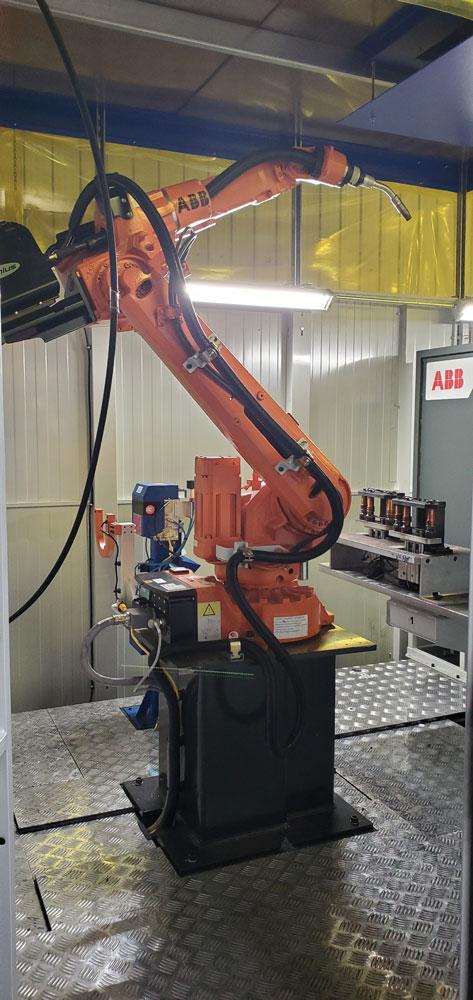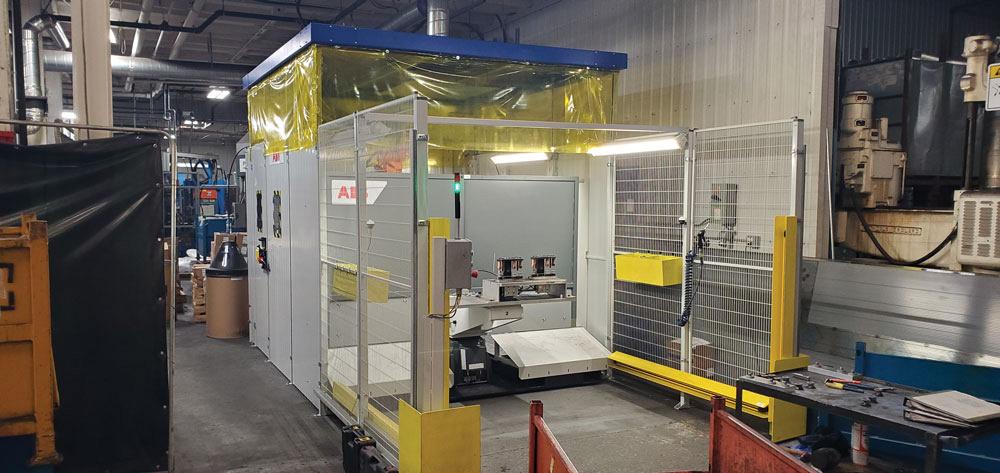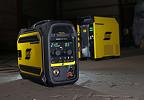Associate Editor
- FMA
- The Fabricator
- FABTECH
- Canadian Metalworking
Robotic weld cell gets the job done right
Trillium Metal Stampings’ robotic welding increases quality control in automotive applications
- By Lindsay Luminoso
- March 10, 2020
- Article
- Welding

Trillium Metal Stampings installed an ABB IRB 2600 arc welding robotic arm with an Abicor Binzel welding torch package at the end of 2019.
Trillium Metal Stampings has been a family owned and-operated stamping, weld, and assembly facility for over 70 years. The company has been passed down for three generations and is currently working on the next continuation plan. Carol Zettel is the current president with her nephew Andrew Zettel as vice-president of operations. Carol’s children, Peter Tebbutt and Sarah Tebbutt, are also part of the Trillium team. Peter is plant manager and Sarah is plant engineer.
Trillium has been manufacturing metal stampings, weld assemblies, and electromechanical assemblies for the better part of 70 years, operating in automotive, appliance, construction, electrical, health care, locomotive, and material handling sectors. Its operations are spread over two Kitchener, Ont., locations. Its stamping equipment comprises 19 automated and manual mechanical press lines ranging from 60 to 800 tons located in its Plant 1 facility. The Plant 2 facility houses light to medium-size assembly and welding operations, which include robotic welding, resistance welding, manual gas metal arc welding, and spot welding.
"We put a 15,000-sq.-ft. addition onto the Plant 1 location in 2018 with another 20,000-sq.-ft. addition planned in the next several years," said Peter Beutler, business development and sales representative. "We have been constantly growing and have almost quadrupled our size and operations since the 2008 recession and now employ around 80 staff members."
The company recently added an 800-ton press, is currently in the process of adding a 600-ton press, and hopes to add another 800-ton press in the near future. The company focuses up to 25 per cent of its business in the automotive sector, which tends to be higher-volume projects. However, one way the company has managed to thrive is through diversification into other industries with over 65 different customers. Many of its projects are in the lower-volume segment. As the company took on more new weld projects, it found a need for additional robotics to keep production flowing.
Robotic Welding Cell
"As we began to take on more new work, we quickly found out that we were at capacity with our existing robotic welding cell," said Beutler. "Mid-2019 we started thinking about adding another robotic welding cell, and by year-end we started the installation process."
Although the company already had a robotic welding cell in place, it wanted to explore its options with other makes and models on the market before settling on the ABB robot with an Abicor Binzel welding torch package.
"One of the selling points for us was service," said Beutler. "They were local so we were able to visit the location and see the equipment. Both the representatives from ABB and Abicor Binzel were able to answer our questions. It was really the service and the local representation that made our decision. I can call and they pick up the phone, answer my questions. If I need replacement parts, I can have them in a couple of days. It certainly made a difference in our decision-making process."
The robotic welding cell was installed within eight weeks just before the end of 2019, which really impressed Beutler. The shop had to move a few things around to accommodate the new cell, but for the most part, work flow was not disrupted.
"It was so quick," he said. "We didn’t even have enough time to build the dies to support the robot. We were able to watch the build and really anticipate how it would fit in with our work flow."
Beutler happily reports that work for the new cell is rapidly expanding, although there is still room to take on more. The shop also hired employees to oversee the robotic welding cell and deal with the expanding capacity.

The robotic welding cell includes an access area that the operator uses to load and unload parts. It also includes a small operator station, to the left, with green indicator on top.
The ABB IRB 2600 arc welding robotic arm came with a turnkey package to fit Trillium’s needs as well. The robotic welding cell includes a Binzel ABIROB® A500 through-arm package, with an ABIROB air-cooled robotic MIG gun and TCS Compact nozzle cleaning station for torch maintenance.
"The robotic arm includes guarding and the latest ‘safe move’ software to prevent the robot from reaching outside the designated virtual barrier," said John Guenzer, maintenance manager. "This can also be adjusted by the end user through software available online from ABB. The robot comes with a nice pendant that is equipped with a joystick to improve control when making program changes. The weld supply is a Fronius Transpuls Synergic 3200. This controller is cutting-edge technology for welding control. We are using a Binzel torch setup with hardened silver-plated contact tips. We use a 0.035 wire and a 90 per cent argon, 10 per using the pulse feature on the Fronius to control spatter."
Currently the robotic weld cell is being used to MIG weld three large nuts onto a base plate as part of a subassembly for an automotive application. Each nut receives three welds approximately 14 mm long. The part then goes to a paint operation and then shipped to the customer.
Quality Control
"Welding has increasingly becomine harder work to deal with because of the new IATF requirements for the automotive sector," said Beutler. "There are a lot of requirements as far as the quality standards and much more documentation to deal with. With these new requirements we’ve had to make our fixtures much more robust."
One way the company was able to comply with these new requirements was to build some safety and poka-yoke techniques right into the robotic welding cell machine, which has helped them across the board with all projects, not just automotive-related ones. This has improved the quality from the fixture level to the robotic level, which has helped the shop become more competitive and more accurately quote future jobs.
"The robot also helps us control certain aspects of the job that require a higher degree of accuracy and repeatability," said Guenzer. "We have very tight flatness and positional tolerances. The robot will repeat the exact same weld length and position every time. Manually, it would be a lot slower process and lack the consistency."
With the new robotic weld cell in place, Trillium has had fewer failures, fewer strain injuries, and increased production capabilities. It has enabled the shop to take on more jobs in-house.
"Robotic welding is becoming more common, particularly with automotive jobs," said Guenzer. "We are seeing profit growth because of the robotic weld cell, and we are also keeping up with technology as it progresses."
Beutler added that the company is trying to use the robotic weld cell more and experimenting with unique ways to maximize its productivity and capacity.
Associate Editor Lindsay Luminoso can be reached at lluminoso@canadianfabweld.com.

The cell includes an auto torch cleaner/reamer/antispatter spray, all in one unit. It cleans spatter out of the torch and trims wire to properly stick out before it returns to welding.
Photos courtesy of Trillium Metal Stampings, www.trilliummetal.com.
ABB Robotics, www.abb.com
Abicor Binzel, www.binzel-abicor.com
About the Author

Lindsay Luminoso
1154 Warden Avenue
Toronto, M1R 0A1 Canada
Lindsay Luminoso, associate editor, contributes to both Canadian Metalworking and Canadian Fabricating & Welding. She worked as an associate editor/web editor, at Canadian Metalworking from 2014-2016 and was most recently an associate editor at Design Engineering.
Luminoso has a bachelor of arts from Carleton University, a bachelor of education from Ottawa University, and a graduate certificate in book, magazine, and digital publishing from Centennial College.
Related Companies
subscribe now


Keep up to date with the latest news, events, and technology for all things metal from our pair of monthly magazines written specifically for Canadian manufacturers!
Start Your Free Subscription- Trending Articles
CWB Group launches full-cycle assessment and training program

Achieving success with mechanized plasma cutting

3D laser tube cutting system available in 3, 4, or 5 kW

Brushless copper tubing cutter adjusts to ODs up to 2-1/8 in.

Welding system features four advanced MIG/MAG WeldModes

- Industry Events
MME Winnipeg
- April 30, 2024
- Winnipeg, ON Canada
CTMA Economic Uncertainty: Helping You Navigate Windsor Seminar
- April 30, 2024
- Windsor, ON Canada
CTMA Economic Uncertainty: Helping You Navigate Kitchener Seminar
- May 2, 2024
- Kitchener, ON Canada
Automate 2024
- May 6 - 9, 2024
- Chicago, IL
ANCA Open House
- May 7 - 8, 2024
- Wixom, MI















